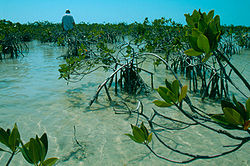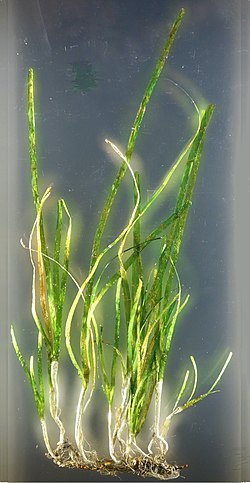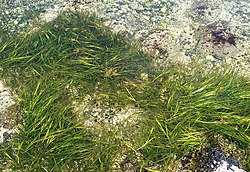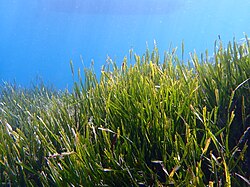Sea grass
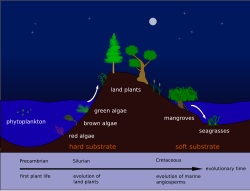
Sea grasses (or seagrass) are flowering plants which live in the sea. They come from four plant families in the order Alismatales. They are monocotyledons which grow in marine, fully saline environments.
Sea grasses evolved from plants which went back to the ocean 70 to 100 million years ago, in the long, warm, Cretaceous period.
Sea grass is a key part of continental shelf ecosystems where phytoplankton produce carbonate sediment. This kind of ecosystem occurs in subtropical places like Florida Bay, and around Bermuda. Sea grass beds often contain many species from various phyla. Apparently, seagrass herbivory is a highly important link in the food chain. Many species feed on sea grasses, such as green turtles, dugongs, manatees, fish, geese, swans, sea urchins and crabs.
The surface of the seagrass is the place where Melobesia, a small alga, makes chalk as a by-product of its metabolism. That is not the only chalk-producing organism in the seagrass beds.[1]
Largest plant
A huge bed of seagrass has been found off the coast of Western Australia.
Researchers collected shoots from the bay and looked at 18,000 genetic markers. It is all from the same plant, and covers about 77 square miles (200 square kilometres).[2]
Sea Grass Media
Underwater footage of seagrass meadow, bull huss and conger eel
Bibliography
- Green E.P. & Short F.T. (eds) 2003. World atlas of seagrasses. University of California Press, Berkeley, CA. ISBN 0-520-24047-2
- Hemminga M.A. & Duarte C. 2000. Seagrass ecology. Cambridge University Press, Cambridge. ISBN 9780521052498
- Hogarth, Peter 2007. The biology of mangroves and seagrasses Oxford University Press. ISBN 9780198568711
- Larkum A.W.D; Orth R.J & Duarte C.M. (eds) 2006. Seagrasses: biology, ecology and conservation Springer. ISBN 1-4020-2942-X

